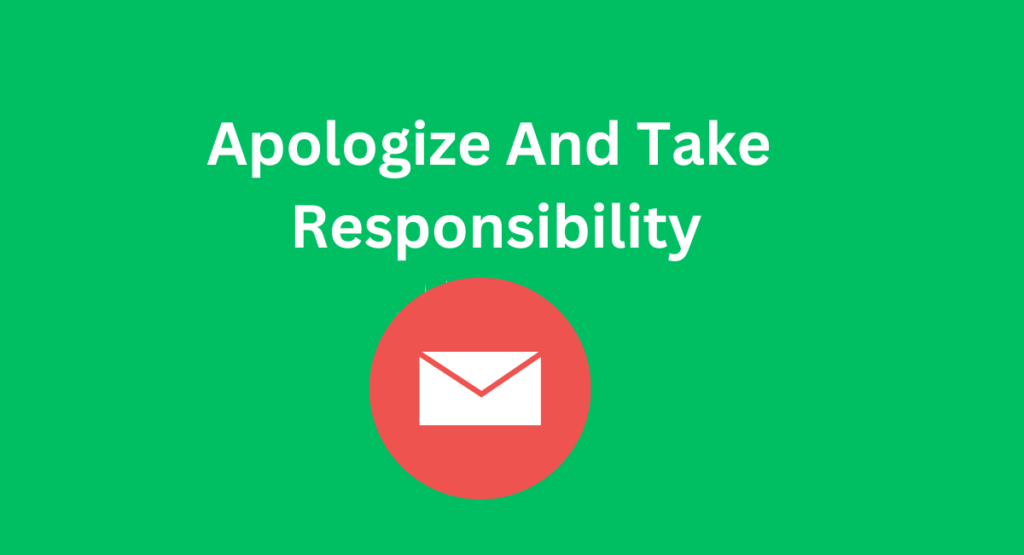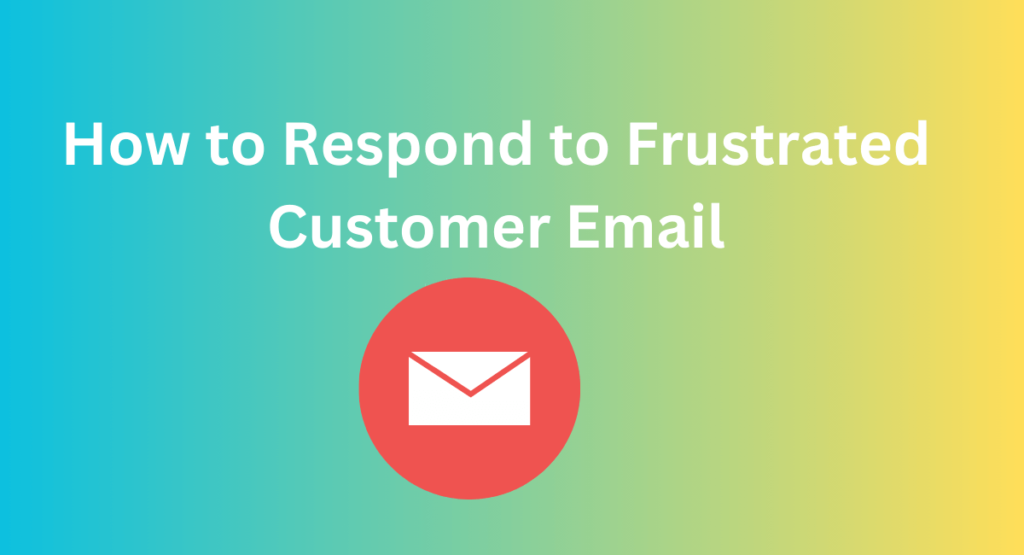To respond to a frustrated customer email, address their concerns promptly, and offer a personalized solution to resolve the issue effectively. Dealing with customer complaints can be challenging, but it is essential to handle them professionally and efficiently.
When a customer reaches out with frustration, it is crucial to respond promptly and effectively. Your response can either alleviate their concerns and retain their loyalty or worsen the situation and potentially lose the customer. A frustrated customer might feel unheard, undervalued, or dissatisfied with your product or service.
Therefore, it is crucial to respond to their email with empathy, understanding, and a commitment to finding a solution. We will provide you with some valuable tips on how to respond to a frustrated customer email effectively. By following these guidelines, you can ensure that your responses are helpful, empathetic, and representative of your commitment to customer satisfaction.
Acknowledge The Frustration
When responding to a frustrated customer email, it’s crucial to acknowledge their frustration. By doing so, you demonstrate empathy and understanding, which can help de-escalate the situation. Acknowledging the customer’s frustration also sets the stage for a more meaningful and productive conversation.
Express Empathy
Expressing empathy towards the customer’s frustrations can go a long way in diffusing tension and building rapport. Let the customer know that you understand their frustration and that you genuinely care about resolving their concerns. Use phrases such as “I understand how frustrating this must be for you” or “I empathize with your situation” to convey your understanding and support.
Validate Concerns
Validating the customer’s concerns involves acknowledging the specific issues they have raised. Show the customer that you take their concerns seriously and that their feedback is important to you. Reiterate the main points of their complaint to demonstrate that you have listened and understood their perspective. This validation can help the customer feel heard and can lay the groundwork for addressing their issues effectively.
Apologize And Take Responsibility

When handling a frustrated customer email, it’s crucial to apologize sincerely while taking full responsibility for the situation. By acknowledging the issue and showing empathy, you can start rebuilding trust and resolving the customer’s concerns effectively. Remember, a genuine apology goes a long way in turning a negative experience into a positive one.
When dealing with a frustrated customer email, it is crucial to respond in a way that acknowledges their concerns and shows empathy towards their experience.
One of the key steps in handling such situations is to apologize and take responsibility for any shortcomings or mistakes that may have caused their frustration. This helps establish trust and demonstrates that you value their feedback and take their concerns seriously.
Offer A Sincere Apology
To begin your response, it’s important to offer a genuine and sincere apology to the customer. Start by acknowledging their frustration and expressing regret for any inconvenience or dissatisfaction they may have experienced. Make sure your apology is heartfelt and authentic, as customers can easily spot insincere or automated responses.
For example:
I sincerely apologize for the inconvenience and frustration you have encountered with our product/service. We deeply regret the negative experience you have had and understand how important it is to address this matter promptly.
Accept Accountability
In addition to offering an apology, take the opportunity to accept accountability for the issue at hand. This demonstrates that you are taking responsibility for the situation and are committed to finding a resolution. Avoid making excuses or shifting the blame onto others, as this can further aggravate the customer.
For instance:
As a representative of [Company Name], I take full responsibility for the inconvenience caused. We understand the impact this has had on your experience and are committed to rectifying the situation to ensure your satisfaction.
By apologizing sincerely and accepting accountability, you are showing the customer that you prioritize their concerns and are committed to addressing the issue at hand. This empathetic approach can help rebuild trust and open the door for a productive resolution.
Provide A Solution

When faced with a frustrated customer email, it’s important to respond promptly and empathetically. Acknowledge their concerns, offer a solution, and assure them that their feedback is valued. By providing a clear and personalized response, you can help address their issues and build a stronger customer relationship.
Offer Resolution Options
When a frustrated customer reaches out via email, it’s important to provide a solution promptly. By offering resolution options, you show that you are committed to resolving the issue and restoring their satisfaction. This step requires understanding the nature of the customer’s problem and considering different ways to address it. Let’s delve into how you can offer resolution options effectively.
Propose Next Steps
After you have suggested some resolution options, it’s time to propose the next steps in your response. Clearly outlining the course of action not only keeps the customer informed but also gives them a sense of control and progress toward a resolution. Here’s how you can propose the next steps in a customer-focused and effective manner.
1. Acknowledge the Issue: Begin by acknowledging the frustration expressed by the customer. Address their concerns directly and let them know that their feelings are valid and heard.
2. Apologize: Offer a sincere apology for the inconvenience or error that caused the customer’s frustration. Taking responsibility shows that you value their satisfaction and are committed to resolving the issue.
3. Outline Available Solutions: Present the resolution options you mentioned earlier as a concise list. Use bullet points or a table to make it more visually appealing and easy to comprehend.
4. Recommend the Best Option: Based on your expertise and understanding of the issue, suggest the resolution option that you believe would be most suitable. Explain why you think this is the best course of action and how it addresses the customer’s concerns effectively.
5. Provide Clear Instructions: Detail how the customer can proceed with their chosen resolution option. If necessary, include step-by-step instructions, links, or references to any relevant resources. Ensure your instructions are straightforward to follow.
6. Offer Assistance: Reassure the customer that you are available to support them throughout the resolution process. Provide contact information, such as a support email or phone number, so they can reach out directly for further assistance if needed.
7. Express Gratitude: End your response by expressing gratitude for the customer’s patience and understanding. Let them know that you appreciate their business and that you are committed to ensuring their satisfaction. By offering resolution options and proposing clear next steps, you can effectively address a frustrated customer’s email. Providing a concrete plan of action demonstrates your commitment to finding a solution and helps regain the customer’s trust. Remember, prompt and empathetic responses are key to maintaining positive customer relationships.
Maintain Professionalism

Responding to frustrated customer emails requires maintaining professionalism. Address the issue promptly, acknowledge their concerns, offer possible solutions, and apologize if necessary. Keep the tone respectful and empathetic while providing clear and concise information to resolve the customer’s problem.
Maintain Professionalism When responding to a frustrated customer email, maintaining professionalism is key to diffusing the situation and turning it into a positive experience. Your response should reflect a high standard of courtesy and respect. Use Positive Language As you craft your response, choose upbeat language.
This can help shift the customer’s mindset and encourage a more positive interaction. Instead of saying “We can’t do that,” try “I understand your concern. Let’s see what we can do.” Avoid Blaming or Arguing Emphasize the importance of avoiding blaming or arguing in your interactions. Instead of pointing fingers or engaging in a debate, focus on understanding the customer’s perspective, acknowledging their frustration, and offering solutions.
By maintaining professionalism, using positive language, and avoiding blaming or arguing, you can effectively respond to frustrated customer emails and potentially turn a negative situation into a positive one.
Follow-up And Follow Through
In responding to a frustrated customer email, it’s important to follow up and follow through. This entails acknowledging their concerns, providing a prompt response, and taking appropriate actions to address their issues and ensure a satisfactory resolution.
Confirm Resolution
Once the frustrated customer’s email has been addressed, send a concise message to confirm the resolution. This reassures the customer that their concerns have been noted and resolved efficiently.
Offer Additional Assistance If Needed
Express willingness to provide further assistance if the customer has any lingering questions or concerns. Offer solutions or alternatives to ensure their complete satisfaction.
Frequently Asked Questions For How To Respond To Frustrated Customer Email
How Do You Respond To A Frustrated Customer Email Example?
To respond to a frustrated customer email, acknowledge their frustration, apologize, and offer a solution. Show empathy and provide clear and concise information to address their concerns. Use a positive and understanding tone to reassure the customer. Keep the communication open for further assistance if needed.
How Do You Respond To Someone Who Is Frustrated In An Email?
Acknowledge their frustration and offer a solution to address their concerns promptly.
How Do You Acknowledge Customer Frustration?
Acknowledge customer frustration by empathizing with their concerns and apologizing for any inconvenience. Offer solutions and ensure their issue is addressed promptly.
How Do You Respond To A Customer Complaint Email?
When responding to a customer complaint email, acknowledge the issue and express empathy. Provide a clear explanation and offer a solution. Act promptly and ensure the customer feels heard and valued. Maintain a professional tone and follow up to ensure satisfaction.
Conclusion
Dealing with frustrated customer emails can be overwhelming, but with the right approach, it can be a valuable opportunity to showcase your exceptional customer service and problem-solving skills. By acknowledging their concerns, providing a personalized response, and offering a feasible resolution, you can turn a negative experience into a positive one, ultimately strengthening the customer relationship.



